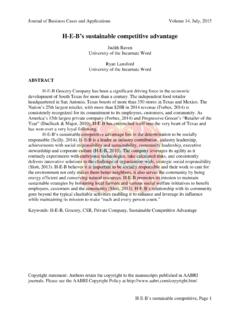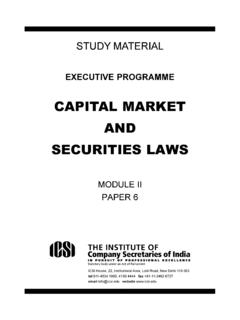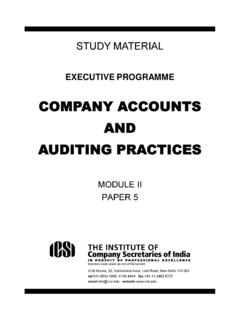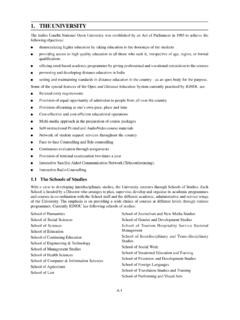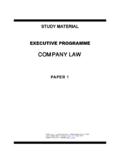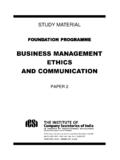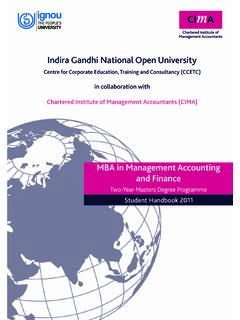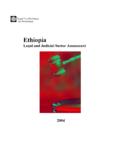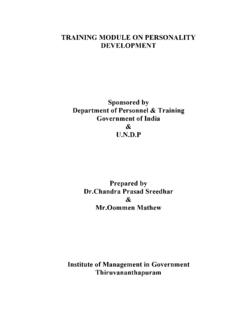Transcription of Using student input to develop a marketing strategy for an ...
1 Journal of Case Studies in Education Using student input , Page 1 Using student input to develop a marketing strategy for an executive MBA Program Gary L. Geissler University of Arkansas at Little Rock ABSTRACT Despite continued growth in the number of executive MBA (EMBA) Programs in the U. S. and worldwide, previous research concerning the marketing of EMBA Programs has been very limited. Here, the author investigates ways to successfully market an EMBA Program at a southern U. S. university. Extensive exploratory research was conducted among current EMBA students and alumni. Among the key findings, professionals seek many benefits from the EMBA degree, including career advancement, higher pay, more employment options, increased confidence, more business knowledge and skills, professor face time, and networking opportunities.
2 A proposed marketing strategy for the EMBA Program is discussed. Keywords: marketing , strategy , executive business education Using student input INTRODUCTION The number of executive MBA (EMBA) Programs continues to increase in the U. S., particularly in the Southeast and Texas/New Mexico regions. EMBA Programs are also experiencing impressive growth worldwide, especially in Europe, Latin America, and Asia. Overall, program growth this decade is projected to outpace growth during the previous decade. This growth is being fueled by increasing demand. For example, EMBA program applications increased 25 percent from 2005 to 2007. As a result, more than half of the executive MBA Council s member programs are considering increasing capacity or opening programs in new locations ( executive MBA Council Membership Program Survey 2007).
3 Despite increasing EMBA Program costs ( , the average 2007 total program cost worldwide was nearly $58,000), the programs offer professionals numerous advantages, such as scheduling convenience, international travel/ study opportunities, and interaction with smart and talented peers. Recent EMBA graduates reported shorter payback periods for both the students and their organizations (an average of 23 months), significant salary increases (21%), and promotions (43%). student evaluations of EMBA Program performance, value, and quality remain high. Moreover, 84 percent of recent EMBA graduates would recommend their program to others ( executive MBA Council student Exit Benchmarking Survey 2007). New students examine various factors when considering and applying to EMBA Programs.
4 The most important factors are quality of the faculty, the school s reputation, the program format, quality of classmates, curriculum/class offerings, location/geographic setting of the campus, and program rankings. Numerous sources are helpful in the decision making process, such as the faculty/staff, admissions process, information session, campus visit, alumni, program web site, current students , program brochure, virtual information session, and program CD-ROM ( executive MBA Council student Entry Benchmarking Survey 2007). BACKGROUND/LITERATURE REVIEW Previous research has examined different aspects of EMBA programs. For example, one study reported that international travel courses do indeed affect cognitive, attitudinal, and behavioral learning of the participants (Schuster et al.)
5 1998). Another study suggests that EMBA programs should serve as a model for traditional MBA programs seeking to provide students with more knowledge concerning the integration of business functions and the synergistic use of core competencies and delivery systems (Latham, Latham, and Whyte 2004). Several studies have investigated discipline-specific focuses of EMBA programs ( , Winter 2002). However, research specifically addressing the marketing of EMBA programs has been very limited. A notable exception is a study that evaluated the marketing orientation of Saint Joseph s University s EMBA Program (Dubas et al. 1998). Another study simply suggested that EMBA Programs offer a bundle of selected business education modules for one price, as opposed to a manager paying for separate conferences and educational organizations to obtain similar knowledge (Stremersch and Tellis 2002).
6 The present study explores ways to effectively market an EMBA Program to its target market. Key insights are gathered from current EMBA students and alumni. In this case, the university is located in a state capital city in the southern United States. The EMBA Program has been successful for more than a decade, although enrollment has declined somewhat in recent Using student input years. This decline and a continuous improvement philosophy were the impetus for this investigation. The EMBA Program offers a comprehensive business curriculum, including discipline-specific courses as well as courses in International Business, Legal and Ethical Issues in Business, and Leadership. students also have the opportunity to participate in an international trip to survey business strategy and culture in other countries.
7 The lock-step program is currently 18 months in length. Classes are held in the college s business building every other Friday evening and Saturday (all day). The average class size is 21. The total program price is very competitive, and it includes the international trip, books, and catered meals. Various promotional methods ( , personal selling and advertising) have been used, although promotional activity in recent years has been relatively less than in the early program years. The program attracts a diverse group of professionals from a wide variety of occupations/industries, such as engineering, healthcare, information technology, accounting, finance, marketing , education, human services, legal services, and general management.
8 The average student age is 40. Most of the students (59%) are male. The faculty has extensive business management and consulting experience. RESEARCH OBJECTIVES The primary research objectives associated with marketing the EMBA program were to: 1. identify key motivations and principal benefits sought in pursuing the EMBA degree. 2. gather feedback and suggestions concerning the overall marketing strategy for the EMBA Program. 3. explore future trends and opportunities that the EMBA Program may be able to capitalize upon. RESEARCH METHODOLOGY EMBA Alumni Focus Group Discussions Two focus group discussions were conducted among EMBA alumni in January, 2009. In total, 20 alumni representing nine previous EMBA classes participated.
9 Each discussion lasted for over two hours. The discussions were audio-recorded to allow for appropriate data analysis. Key themes were identified and supported by representative quotes, as detailed in the following Research Findings section. EMBA Current students Focus Group Discussions Focus group discussions were also conducted among 12 current EMBA students , as part of two separate marketing strategy classes in January, 2009. In total, the discussions lasted for around four hours. As with the alumni focus groups, the discussions were recorded, and emergent themes were identified and supported by representative quotes. Using student input RESEARCH FINDINGS student Motivations Initially, focus group participants were asked to write down their reasons for pursuing the EMBA degree at this university and the benefits that they were seeking in the educational experience.
10 Then, they were asked to discuss each. The main reasons that EMBA alumni and current students stated for pursuing the degree included location, scheduling convenience, professional growth, career advancement, networking opportunities, and the university s reputation. Some typical comments follow: I pursued the EMBA here mainly for the ability to continue my education while working at the same time. I wanted to attend somewhere local. And, because business is my current field, the EMBA Program at (this university) was perfect. I desired an MBA for professional growth and to become well- rounded. I chose the EMBA for the structure and timeframe. I chose (this university) because of location and reputation and like-minded individuals.


